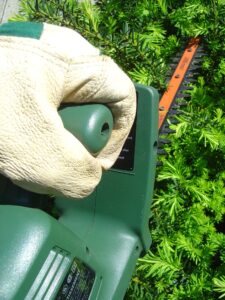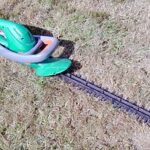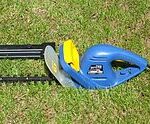As an Amazon Associate, this site earns commissions from qualifying purchases. For more information click here.
Bushes and shrubbery can make any garden look good. But these turfs can grow fast quickly if not regularly maintained. Fortunately there are a number of tools you can use including hedge trimmers. Cutting bushes not only makes your landscape more appealing, but it helps plants because you get rid of dead branches, giving it room to grow.
A hedge trimmer makes it easy to cut bushes, shrubs and hedges. Let the blade run along the top and sides and try to maintain a wider base than the top. An electric or battery powered hedge trimmer should get the job done in most cases.
The Benefits of Pruning with a Hedge Trimmer
When it comes to trimming hedges, bushes and shrubs, the choices are a hedge trimmer or shears. Both are very useful and have their own pros and cons. But overall hedge trimmers are the more ideal especially if you have a lot of shrubbery to cut.
The biggest benefit of a hedge trimmer is it is a motorized, engine powered machine. Manual shears may give you précis control, but if you want to trim and cut large amounts of material, hedge trimmers are the better option.
There are three types of hedge trimmers: electric, gas and battery. In most instances a battery or electric corded model will be sufficient. Both are affordable and convenient to use.
An electric corded trimmer will never run out of power as long as it is connected to a power source. A battery meanwhile, gives you freedom of movement. And if you need more power there are gas operated hedge trimmers available.
Manual shears are fine for small bush work but if you need to maintain lots of them on a regular basis, it is better to buy a hedge trimmer. Put it simply you will get more work done in less time.
How to Cut Bushes with Hedge Trimmers
This video demonstrates how to maintain bushes and shrubs with a hedge trimmer. If you prefer written instructions, follow the step by step guide blow.
First you should prepare the following tools and materials. Just like cutting grass , it takes some planning to trim bushes and shrubs.
Required Tools and Materials
- Hedge trimmer (recommendation (Craftsman V20 Cordless trimmer)
- Work gloves
- Safety glasses
- Pruner or garden shears (recommendation: EZ Kut G2 Loppers)
- Tarp
- String
- Posts or stakes
- Level
Step 1
The first thing you have to do is set the bush height. That is, the point where you want to trim it. For instance, you can cut the bush where branches are sticking out.
Place two stakes on each end of the bush and fasten a string onto them. Keep the string as straight as possible. The stakes should be the height you want for the bush. You may also use a level for more precision trimming.
Step 2
Once you have determined the height, put a tarp under the bush. This will catch all the falling foliage, branches and debris. Once you are done trimming, dispose of the debris properly. If you have several shrubs to trim, empty the tarp first then lay it before the bush you have to cut next.
Step 3
Turn your hedge trimmer on and start cutting. Keep the blade above the string to get an even appearance. Beaus the blade is motorized, you get a smooth finish. The key is to maintain the level above the stakes.
As you cut, make sure the top is narrower than the bottom. Take a break after a few minutes to see how you are doing. Cut off any branches or leaves that are out of place. With a hedge trimmer you can do the job faster compared to manual shears.
Step 4
After trimming the top you can move on to the sides. Cut the bush so there is a space of at least 6 inches / 15 cm from the walls of your home. If you can space it by up to 12 inches / 30 cm that is even better. The reason you want to do this is to keep the plants from touching the walls.
Why would you want to do that? You need to water these plants so they can live. But if the shrubs are right next to your wall, the water could weaken the material and could seep through.

Step 5
Get on your knees if necessary and start cutting from the bottom of the bush. Work your way up until you reach the string.
Cut as smoothly as possible, letting the blade do the heavy lifting. Your cuts should be at a slight angle like a slope. Step back and take a look. If the bottom is wider than the top you are doing it right. This will allow sunlight to reach the bottom part of the shrubs and keep its uniform color.
Step 6
Now that you are done, look carefully over the bush. Remote any overgrown branches or leaves that stick out. In this case you may want to use a pruner as it gives you more control.
Tips on How to Cut Bush Efficiently
Do not remove more than a third of the bush. Cutting more than that can weaken it . It is better to make shallow cuts because you can always trim more later.
The rule of thumb is to trim no more than 1-3 inches per cutting sweep. If the bush is still too high, cut it again, no more than 3 inches. Keep repeating until you have attained the look that you want.
The thickest branches are at the base. You can use hedge trimmers here but only up to a point. If the branches are more than an inch thick, use pruning shears or a pole saw.
If there is a lot of branch overgrowth in the middle, remove them with your hedge trimmer. Do this only for overgrown branches, and do not remove all of them.
If you are using an electric hedge trimmer, be mindful of the cord. Do not let it get entangled with the bushes because you might accidentally cut it.
Frequently Asked Questions
When is the best time to prune bushes?
You can perform light trimming anytime. If the shrubs have summer flowers, the best time is late winter or early spring. If the flowers form in early spring, trim it following their bloom. If the plants do not flower, just wait for the growth to fully appear.
Which type of hedge trimmer is best for shrubs and bushes?
An electric hedge trimmer should be enough for most homeowners. The only concern is if the cord is too short, but you can always get an extension cord if necessary. If the bush is not that far from the power source – or you have a long cord – then this will not be a problem.
A battery or cordless hedge trimmer is the best option for small shrubs and bushes. Today’s cordless hedge cutters can last a long time so you should be able to get so work done before the battery will require a recharge.
I tried to cut a branch and my hedge trimmer stopped working. Why?
The branch was too large for the blade. Most hedge trimmers can only cut branches up to 3/4 of an inch thick. If the branch is any bigger, the blades will not be able to move.
Related. Can hedge trimmers cut branches
How often should I prune bushes and shrubs?
It depends on how large it gets and what type of look you are going for. The one thing to keep in mind is to never trim more than a third of the shrubs. If you cut away more than half it could seriously hurt the shrubs and may not recover.
Can I use an electric hedge trimmer on wet shrubs?
Never use an electric hedge trimmer on wet plants. Never use an electrical equipment in rainy weather and do not allow it to touch a wet surface.

I love the outdoors and all the tools for maintaining gardens, yards and lawns. The only thing I am more passionate about is sharing what I know about garden and outdoor equipment.


